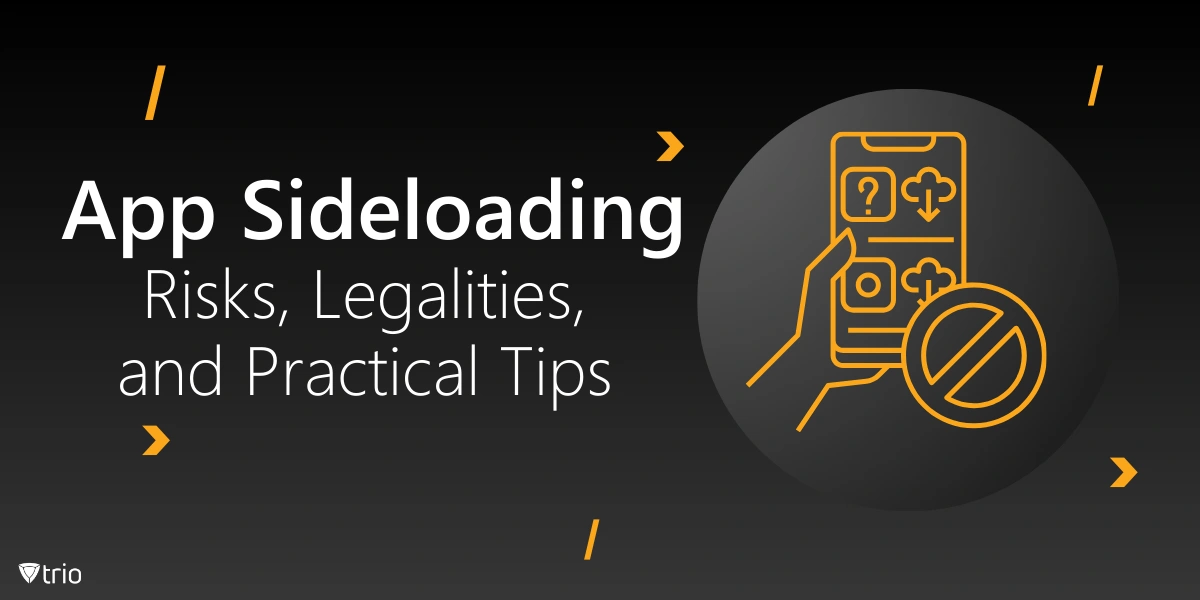When it comes to installing applications on your device, you’re probably used to the smooth process offered by official app stores like Google Play or Apple’s App Store. But there’s another route—sideloading. It’s the practice of manually installing apps from outside the official stores, and it’s getting attention for both its flexibility and its risks.
Why is sideloading such a hot topic? While it offers freedom to access apps that might be restricted or unavailable, it also comes with significant risks, like potential malware and legal complications. Whether you’re curious about unlocking hidden apps or worried about the dangers, this guide is for you.
Here, we’ll explore the risks, legalities, and practical tips surrounding sideloading. By the end, you’ll know what app sideloading is, how to do it safely, and whether it’s the right choice for you.
What Is Sideloading?
Sideloading an app involves the process of app installation directly onto your device, bypassing the official app stores like the Google Play Store or Apple App Store. Unlike the usual method where you tap “install” in an official store, sideloading requires manually adding the app, often from less regulated sources. This process might sound a bit techy, but it’s basically like copying a file from your computer to your phone, skipping the “approval” that comes with official app stores.
When you download from the Google Play Store or Apple App Store, you get apps that have passed a security check. They’re vetted, tested, and deemed safe for use. Conversely, Sideloading opens the door to apps that haven’t gone through such stringent checks. This freedom can be appealing, but it also comes with risks—like downloading an app that’s carrying something you didn’t expect.
If you’re using an Android device, you’ll encounter the term APK, which is short for Android Package Kit. Installing an APK is the technical way to sideload an app on Android. An APK is a container that holds all the files needed to install and run an app on your device. For iOS devices, the process is slightly different but similar in concept.
Sideloading often involves using third-party app stores or downloading directly from a website. These party app stores are where you’ll find apps that aren’t available on official platforms. While this might seem like a win, remember that these sources lack the rigorous security checks of official stores, making them a potential risk.
Sideloading Cybersecurity
When sideloading, you’re opening the door to potential cybersecurity risks. This can include nasty surprises like malware that sneaks in with the app, potentially leading to data breaches. Without proper security measures, sideloading can expose your device to significant threats.
Although sideloading involves downloading from unofficial sources, choosing trusted sources is crucial to maintaining When you sideload from unknown or shady places, you’re gambling with your company’s IT security. These unverified apps might look harmless but can easily compromise your device’s security, leading to loss of sensitive data or worse.

Mitigating Risks
Always consider downloading and installing apps from trusted sources to keep your device safe. It’s also wise to use antivirus software and ensure your system is regularly updated. This acts as a protective shield and minimizes the risks associated with sideloading.
Think of yourself as a human firewall—you have the power to block potential threats before they reach your device. By practicing cautious sideloading and staying informed, you can significantly reduce the risks while still enjoying the flexibility sideloading offers.
Legality of Sideloading
You might be wondering, is sideloading even legal? The short answer is yes; in most places, sideloading is perfectly legal. For example, the European Union supports it through legislation like the Digital Markets Act (DMA). This act encourages fair competition and consumer choice, allowing users to sideload apps without any legal trouble.
However, the legality of sideloading can vary depending on where you live. While the European Union is pushing forward with the Digital Markets Act to promote sideloading, other regions might have stricter rules. This means it’s crucial to know the laws in your area before diving into sideloading.
However, it’s important to remember that sideloading doesn’t give you free rein to do whatever you want. It can become illegal when used to pirate apps or bypass DRM (Digital Rights Management) protections. Downloading a paid app for free or stripping away an app’s built-in restrictions might land you in hot water legally, regardless of your intentions.
To stay on the right side of the law, it’s essential to sideload responsibly. This means avoiding shady practices like pirating apps. Remember, sideloading can be a useful tool, but it’s not worth risking legal consequences by engaging in illegal activities like bypassing DRM protections.
Differences Between Sideloading and Downloading
Now that we’ve covered the legal landscape, it’s time to dive into how sideloading stacks up against downloading from official sources. The choice between sideloading and using official app stores boils down to balancing ease, safety, and control.
Ease of Use: Simplicity vs. Freedom
Official stores are unbeatable in terms of convenience when it comes to installing an app. They’re designed to be user-friendly, guiding you through the process with minimal effort. However, alternative app stores and sideloading give you more freedom, albeit with extra steps that might feel inconvenient if you’re used to smooth, one-click installations.
Safety: Risks Lurking in the Shadows
Security measures on official stores are tight, with rigorous vulnerability management to ensure apps are safe. Sideloading lacks this layer of protection, leaving your device open to potential threats. Without the same safety nets, sideloading can feel like walking a tightrope—you’re in control but one wrong move could lead to trouble.
Control and Flexibility: Your Device, Your Rules
Sideloading shines when you want full control over which apps to install. Whether it’s niche tools or apps restricted by region, you can install the apps you want, regardless of official store availability. This flexibility is empowering, especially if you value having unrestricted access to your device’s full potential.
Sideloading Apps on iPhones
Apple has long taken a hard stance against sideloading iOS apps. The company insists that keeping iPhones within the tightly controlled ecosystem of the App Store is essential for user safety. Apple argues that sideloading bypasses its strict security measures, potentially exposing users to malware, privacy breaches, and compromised apps.
Apple’s resistance stems from its commitment to security and user experience. By discouraging sideloading, they maintain a walled garden that’s easier to control and protect. Their argument is simple: allowing sideloading could open up vulnerabilities that their current safeguards are designed to block.
However, future legislation might force Apple’s hand. The European Union’s Digital Markets Act is designed to increase competition and could require Apple to allow sideloading. This could bring significant changes for iOS apps, providing more flexibility while also introducing greater risks, especially with unregulated app sources.
If Apple is forced to permit sideloading, iOS users might gain more freedom but at the cost of security. While it’s exciting to think about accessing apps beyond the App Store, the risks—ranging from malicious software to unstable apps—mean users would need to be extra vigilant in choosing what to install.

Practical Guide to Sideloading
Now that we’ve explored the risks and legalities, let’s get practical. If you’re still interested in sideloading, here’s how to do it safely on both Android and iOS.
Sideloading on Android
To sideload apps on your Android device, you first need to enable “Unknown Sources” in your settings. This allows installing an APK from outside the Google Play Store. Sometimes, you’ll need to enable Developer Mode as well. To do this, go to Settings > About Phone > Tap “Build Number” seven times, then toggle the Developer Mode options.
Sideloading on iOS: What’s Different?
On an iOS device, the process is trickier. Unlike Android, sideloading here requires developer credentials, which can be complex for non-developers. First, you need to install a tool like AltStore or Cydia Impactor. Then, manually add the app you wish to sideload. Apple’s tight security makes installing iOS apps this way more restrictive.
Using Tools
For a more streamlined experience, tools like Sideload Launcher help manage sideloaded apps on your mobile device. However, make sure to verify the tool’s safety. While effective, they come with their own risks, so always download from trusted sources and keep security in mind.
Integrating Sideloading with MDM Strategies
For organizations using Mobile Device Management (MDM) systems, sideloading presents both opportunities and risks. With the right application whitelisting policies, companies can allow safe sideloading within a digital workspace while maintaining strict security protocols. Proper MDM setups help organizations manage sideloaded apps, ensuring they don’t compromise the security of any mobile device.
Meet Trio, our company’s MDM solution, designed to help organizations manage and control mobile devices effectively. Trio enhances mobile security through robust features like application whitelisting and policy enforcement. Interested? We offer a free demo for those wanting to elevate their mobile device management and security strategies.
Conclusion
We’ve covered a lot, from understanding what sideloading is to examining the legal and security implications. Whether you’re installing applications for more flexibility or simply curious, it’s clear that sideloading offers both opportunities and risks. Knowing the differences between official app stores and sideloading options is key to making informed decisions.
Before diving in, remember the risks—potential malware, legal pitfalls, and the challenge of ensuring app security. Understanding these factors, along with the laws that govern sideloading in your region, is crucial to avoiding unwanted consequences.
Ultimately, sideloading can be a great tool if approached cautiously. Stay informed, use trusted sources, and always weigh the risks against the benefits. By taking these precautions, you can sideload apps while keeping your device and data secure.
Know about news
in your inbox
Our newsletter is the perfect way to stay informed about the latest updates,
features, and news related to our mobile device management software.
Subscribe today to stay in the know and get the most out of your mobile
devices with our MDM solution app.
Recent Posts

Erase the Risk: Protect with Zero Standing Privileges
Learn how zero standing privileges eliminate persistent access rights, enhance data security and reduce the risk of unauthorized access.

Understanding Access Control Types in Cybersecurity w/ Examples
Thorough understanding of access control types & the knowledge to make informed decisions about implementing security measures in your organization.

Cloud Data Protection: Safeguarding Information in the Cloud
Learn essential strategies for robust cloud data protection, exploring tools, best practices, and policies that safeguard sensitive information.





